The Plextor M8Pe (512GB) SSD Review
by Billy Tallis on December 14, 2016 9:00 AM ESTRandom Read Performance
The random read test requests 4kB blocks and tests queue depths ranging from 1 to 32. The queue depth is doubled every three minutes, for a total test duration of 18 minutes. The test spans the entire drive, which is filled before the test starts. The primary score we report is an average of performances at queue depths 1, 2 and 4, as client usage typically consists mostly of low queue depth operations.
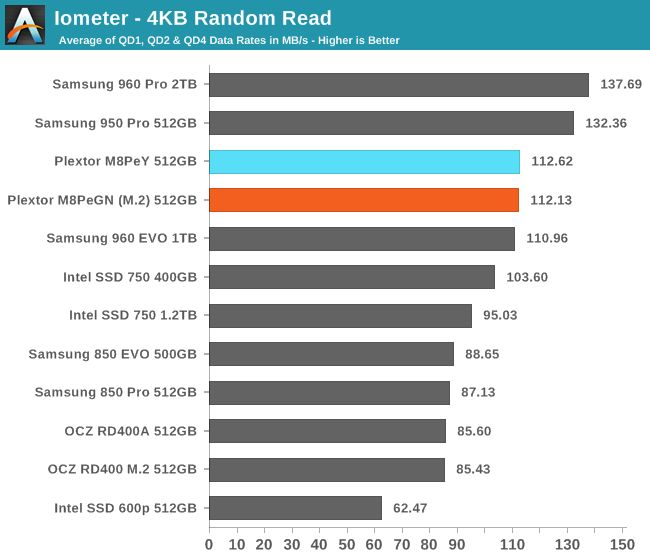
The Plextor M8Pe's random read speed cannot match Samsung's 3D MLC-based 950 Pro or 960 Pro, but it is otherwise very good. The 30% lead over the OCZ RD400 is particularly notable given that it uses the same NAND as the M8Pe.
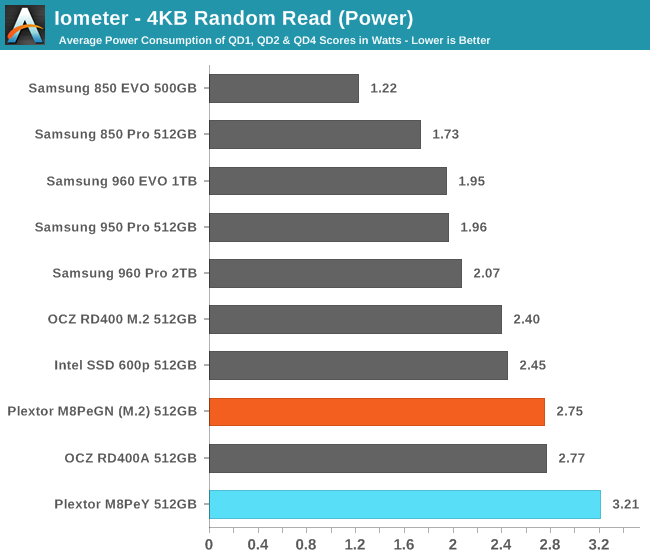
Power consumption is again higher than the rest of the M.2 PCIe SSDs, but given the good performance it does manage to be more efficient than the OCZ RD400.
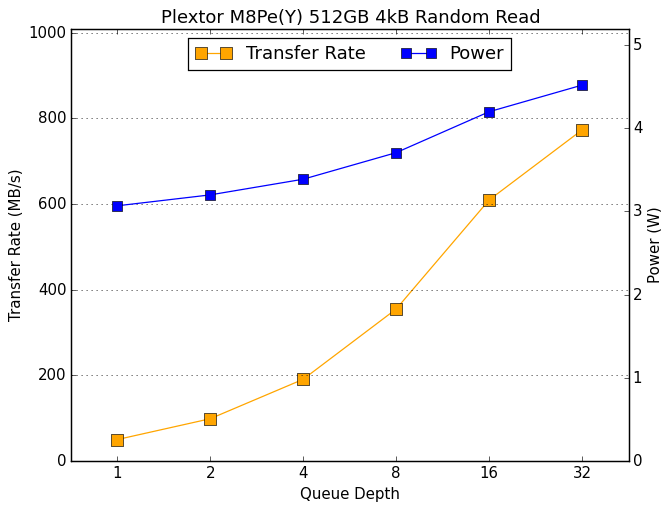 |
|||||||||
It appears that there is a little bit of thermal throttling happening on the M8PeGN in the final phase of the test at QD32, but otherwise it scales well as queue depths increase. Samsung's SSDs mostly saturate at QD16 while the M8Pe continues to scale up, albeit with diminishing returns.
Random Write Performance
The random write test writes 4kB blocks and tests queue depths ranging from 1 to 32. The queue depth is doubled every three minutes, for a total test duration of 18 minutes. The test is limited to a 16GB portion of the drive, and the drive is empty save for the 16GB test file. The primary score we report is an average of performances at queue depths 1, 2 and 4, as client usage typically consists mostly of low queue depth operations.
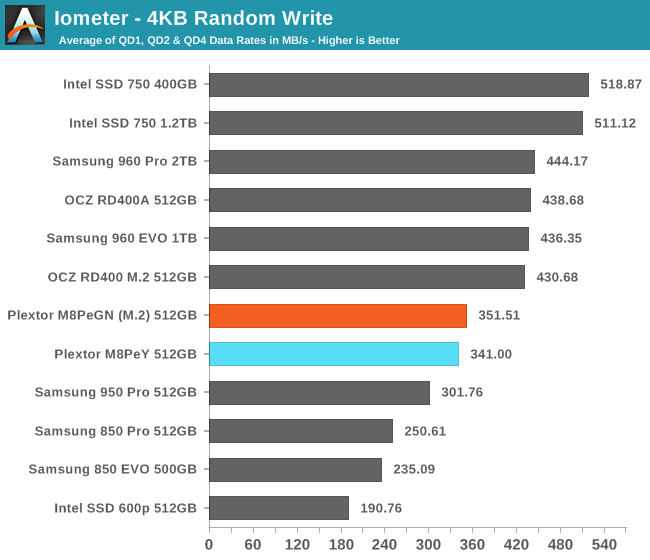
The random write performance of the Plextor M8Pe is better than the Samsung 950 Pro but falls behind more recent MLC-based PCIe SSDs, and Intel's SSD 750 is still the best.
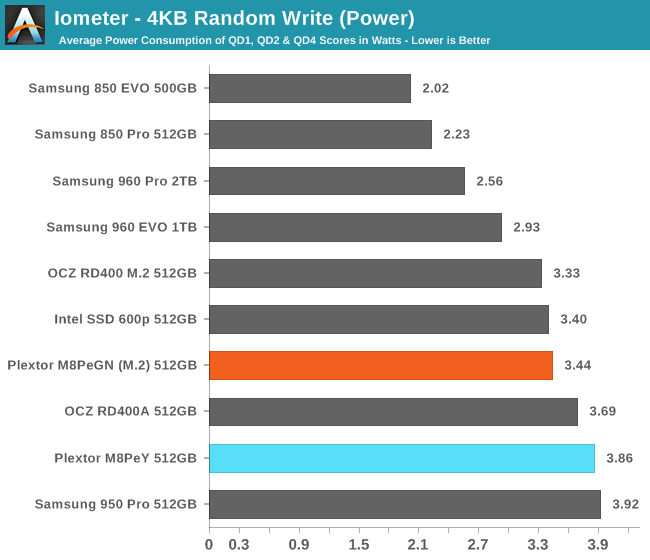
The M8Pe's power consumption is only slightly worse than the OCZ RD400, but its efficiency is still substantially worse. The Samsung 950 Pro had even higher power consumption and delivered what is now unimpressive random write performance, so the M8Pe isn't the least efficient of the MLC-based SSDs.
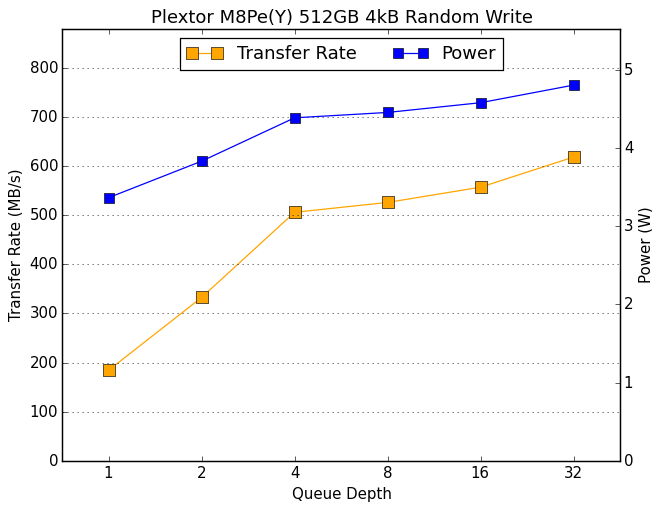 |
|||||||||
Performance increases relatively slowly for the M8PeY in the second half of the test, and actually decreases for the M8PeGN, indicating thermal throttling as power consumption hits 4 W.










64 Comments
View All Comments
GoMoeJoe - Friday, December 16, 2016 - link
Nand shortages ... L o L ...So much fake news. So much WoW !
frenchy_2001 - Friday, December 16, 2016 - link
"The M8Pe's consistency scores are quite low, indicating that it lacks the tight regulation of Samsung and Intel's best drives that have similar average performance."This is rather misleading and shows again the little alue your consistency metric brings.
In the case of the Plextor, it has a well defined floor around 25kops and bursts of speed above that. Although it makes it inconsistent, it has a high minimum.
This would be like complaining that a core i7 with turbo boost is inconsistent, because although it has a 4GHz floor, it sometimes boosts to 4.5GHz when possible and as such is worse than a constant i3 at 2GHz...
MrSpadge - Monday, December 19, 2016 - link
Billy is saying just that in the next paragraph. If you read both together it's like "graph A indicates... however, graph B show that it's really..."helvete - Wednesday, January 11, 2017 - link
Who would buy 1TB variant w/ a heatsink for $650 when one can take 1TB bare plus 128GB w/ a heatsink for $616 ($516 + $100). Then transfer the heatsink and the drive is still $34 cheaper and the 128GB remains remains as a free bonus:-)